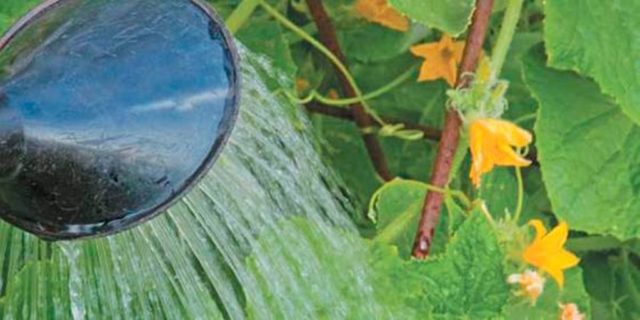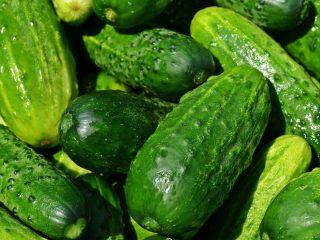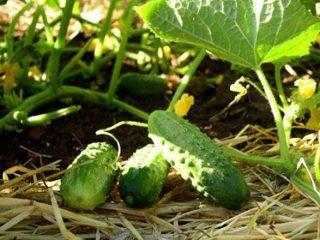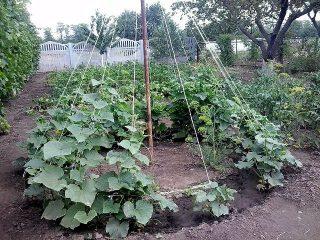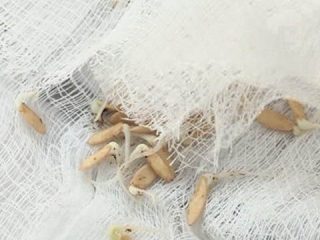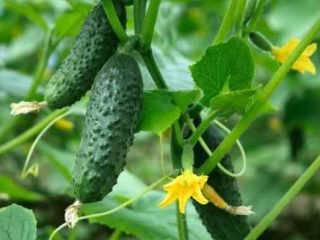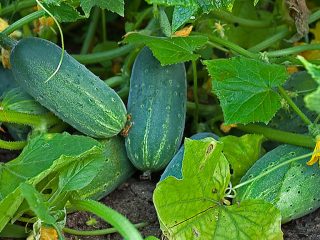Content
Cucumber is the most delicious and favorite vegetable among Russians. It is grown in every household plot in all regions of Russia. It is difficult to grow cucumbers in areas with an unstable climate. But then hybrids come to the rescue. One of the highest yielding and early ripening is the Connie F1 cucumber. This is a self-pollinating hybrid of early maturation. Its pleasant crunch, great taste and aroma will appeal to adults and children.
History of variety selection
The Connie variety appeared in the 90s, thanks to the crossing of cucumber varieties with different dominant traits. The hybrid was developed by Soviet scientists of the Union of Seed Producers “Biotechnics Association” in St. Petersburg. After some research, in 1999, the Connie cucumber variety was included in the State Register. Thanks to this, Connie became available for cultivation throughout Russia.
Description of the cucumber variety Connie
An early-ripening variety of cucumbers forms a powerful, medium-climbing bush with unlimited growth. The plant is medium leafy, female flowering type.Due to the absence of male flowers, the plant produces a large number of greens, which are arranged in bunches of 5–9 pieces. in the node.
The leaves are small, wrinkled, with a light fleecy coating, and painted in a dark emerald color.
Description of fruits
The fruits of gherkin-type cucumbers reach 7–9 cm in length. The proportional, cylindrical-oval shape is finely tuberculate with pronounced snow-white pubescence. The weight of the fruit varies from 60 to 80 g. The taste of the fruit is good. The pulp is dense and juicy, with a characteristic crunch, without bitterness. The skin is thin, dark olive color. According to gardeners, Connie's cucumbers ripen smoothly and do not outgrow.
Characteristics of the variety
All characteristics of the Connie variety cucumber, according to the description and reviews of summer residents, have positive indicators.
Productivity and fruiting
The variety is high-yielding and early ripening. The first gherkins appear 2 months after sowing, the yield is 9 kg per plant. Secondary harvest – 12–16 kg per square meter. m.
To grow a good harvest of cucumbers, you need to follow the rules of care, grow cucumbers in compliance with temperature and humidity conditions and collect greens in a timely manner.
Application area
Thanks to the thin skin and juicy, dense pulp without voids, the fruits are suitable for all kinds of preservation. Fresh crispy cucumbers will become indispensable in preparing summer salads.
Resistance to diseases and pests
The hybrid variety is immune to powdery mildew and root rot. It also tolerates sudden temperature changes and unfavorable climatic conditions.But in order to avoid problems, it is necessary to carry out preventive measures in a timely manner.
Advantages and disadvantages of the variety
The Connie cucumber variety can be grown outdoors and under film cover. But before purchasing seeds, you need to familiarize yourself with the pros and cons of the variety.
The advantages include:
- High yield and early ripeness.
- Resistance to diseases and temperature changes.
- Friendly yield of fruits within 4–5 weeks.
- Lack of barren flowers.
- Good taste without bitterness.
- Female type of flowering.
- Bundle formation of ovaries.
- No voids in the pulp during preservation.
Like any variety, Connie has disadvantages. Some gardeners do not like the small tubercles and white pubescence, as well as the small size of the fruits. Since the bush is tall and produces long lashes, the variety needs support or garter.
Rules for planting and care
Cucumbers of the Connie variety are grown in seedlings and without seedlings. When growing cucumbers through seedlings, the bushes are resistant to low temperatures, and the crop ripens much earlier.
Planting seedlings
Cucumber seeds are sown for seedlings in April, 2 months before planting in open ground. To do this, prepare nutritious soil with weak or neutral acidity and begin planting. To obtain healthy and high-quality seedlings, you must follow simple rules:
- cucumber seeds are kept for 10 minutes in a weak solution of potassium permanganate, rinsed in water and treated in a growth stimulator;
- the prepared material is planted to a depth equal to the length of 2 seeds;
- for better germination, make a microgreenhouse so that the temperature is maintained at +24 degrees;
- after seed germination, the film is removed;
- at the stage of 2–3 true leaves, seedlings are picked and fertilized;
- If necessary, seedlings are illuminated.
Healthy and high-quality seedlings have 3-4 brightly colored leaves and a powerful, straight stem.
Young cucumber seedlings are planted in open and closed ground after the spring frosts have ended. Planting is carried out in soil heated to + 15 degrees. The best predecessors are: legumes, pumpkin crops, tomatoes, cabbage, radishes or potatoes.
Since the Connie variety is vigorous, per sq. m plant no more than 2 bushes.
Before planting grown seedlings, prepare the beds:
- The soil is dug up, weeds are removed and watered generously.
- After 2 days, planting holes are prepared in a checkerboard pattern. Chalk, wood ash or dry manure are poured into the bottom and spilled generously.
- The seedlings are planted in prepared holes and left without watering for several days. This is necessary for adaptation and rapid rooting.
- If the seedlings are elongated, they are planted deeper or the elongated stem is sprinkled with peat or sawdust.
- For the first time, you need to make a shelter.
Growing Connie f1 cucumbers using the seedless method
Seeds are sown in a permanent place after the ground warms up to +15 degrees. Since cucumber is a heat-loving crop, choose a sunny place without drafts. To obtain a generous harvest, the soil must be well fertilized.
When sowing cucumbers without seedlings, before planting, it is necessary to soak the seed for 20–30 minutes in a weak solution of potassium permanganate, rinse with water and dry. The dried seeds are powdered with Trichodermin powder.
2 days before planting, I dig up the soil and fertilize it.Make holes in a checkerboard pattern, put humus or compost on the bottom and spill it generously. Prepared seeds are planted to a depth of 2 cm, 2–3 pieces each. If cucumbers are grown in open ground, the beds are covered with film for 3–4 days. After germination, the strongest seedlings are left. The film is removed, and the plant is carefully hilled up, sprinkling part of the stem.
Aftercare for cucumbers
Growing Connie F1 cucumbers is not difficult; even a novice gardener can handle it. But to get a rich harvest, you need to put in a little effort and care, as well as follow simple care rules.
When growing cucumbers in open ground:
- Water only when the soil dries out, in the morning or evening. When fruits are forming, irrigation is abundant and regular.
- After watering, the soil is loosened and mulched.
- If the soil is well fertilized, fertilizing is not needed. If the soil is depleted, then at the stage of plant growth the soil is fertilized with nitrogenous fertilizers, during the flowering period - with phosphorus-potassium fertilizers, and during the period of fruit formation - with complex mineral fertilizers.
- Since the bush of the Connie variety is spreading and the vines are long, support is necessary. It will simplify the collection of fruits and protect the plant from drafts.
For greenhouse cucumbers, other care rules:
Temperature control – cucumber does not grow well if the temperature is too high. Ventilation is necessary to regulate the temperature.
But if the greenhouse is in the open sun, and open doors do not reduce the temperature, then experienced gardeners spray the walls with a weak chalk solution. The chalk solution will create diffused light.
- Air humidity – cucumbers of the Connie variety grow well at air humidity of at least 90%. To maintain air humidity, plants are periodically sprayed.
- Watering – Irrigation of cucumbers is carried out with warm, settled water 2-3 times a week. During the fruiting period, watering is increased.
- Loosening and mulching – so that water and air penetrate to the root system. The first loosening is carried out a month after planting, then after each watering. Mulching will save you from frequent watering, weeds and will provide additional feeding.
- Prevention of diseases and insect pests – regular inspection of the bush. When the first signs of the disease appear, timely treatment is necessary. To prevent the appearance of diseases, it is necessary to regularly ventilate, remove weeds and yellowed leaves, and maintain temperature and humidity conditions.
You can increase the yield of Connie cucumbers in a greenhouse thanks to carbon dioxide. To do this, a barrel with manure and water in the fermentation stage is installed in the greenhouse.
Bush formation
Since the Connie cucumber variety is indeterminate (unlimited in growth), it is necessary to form a bush.
Rules for pinching the Connie variety:
- in the axils of 4–5 leaves, blinding is done, all flowers and leaves are removed;
- above the sixth leaf, side shoots no longer than 25 cm are left;
- the next 2–3 shoots are left 40 cm long;
- then all shoots should be 50 cm long;
- if the top has reached its maximum length, it is pinched or twisted through the upper trellis and lowered.
Photo of Connie pinching cucumbers in the greenhouse:
Forming and gartering cucumbers, video:
Conclusion
Cucumber Connie F1 is a godsend for the gardener.It is unpretentious in care, resistant to fungal diseases and is suitable for growing both in a greenhouse and in open ground. The fruits of cucumbers are juicy, crispy and aromatic, do not fade for a long time and are well transported. The Connie variety can be grown both for individual consumption and on an industrial scale.



